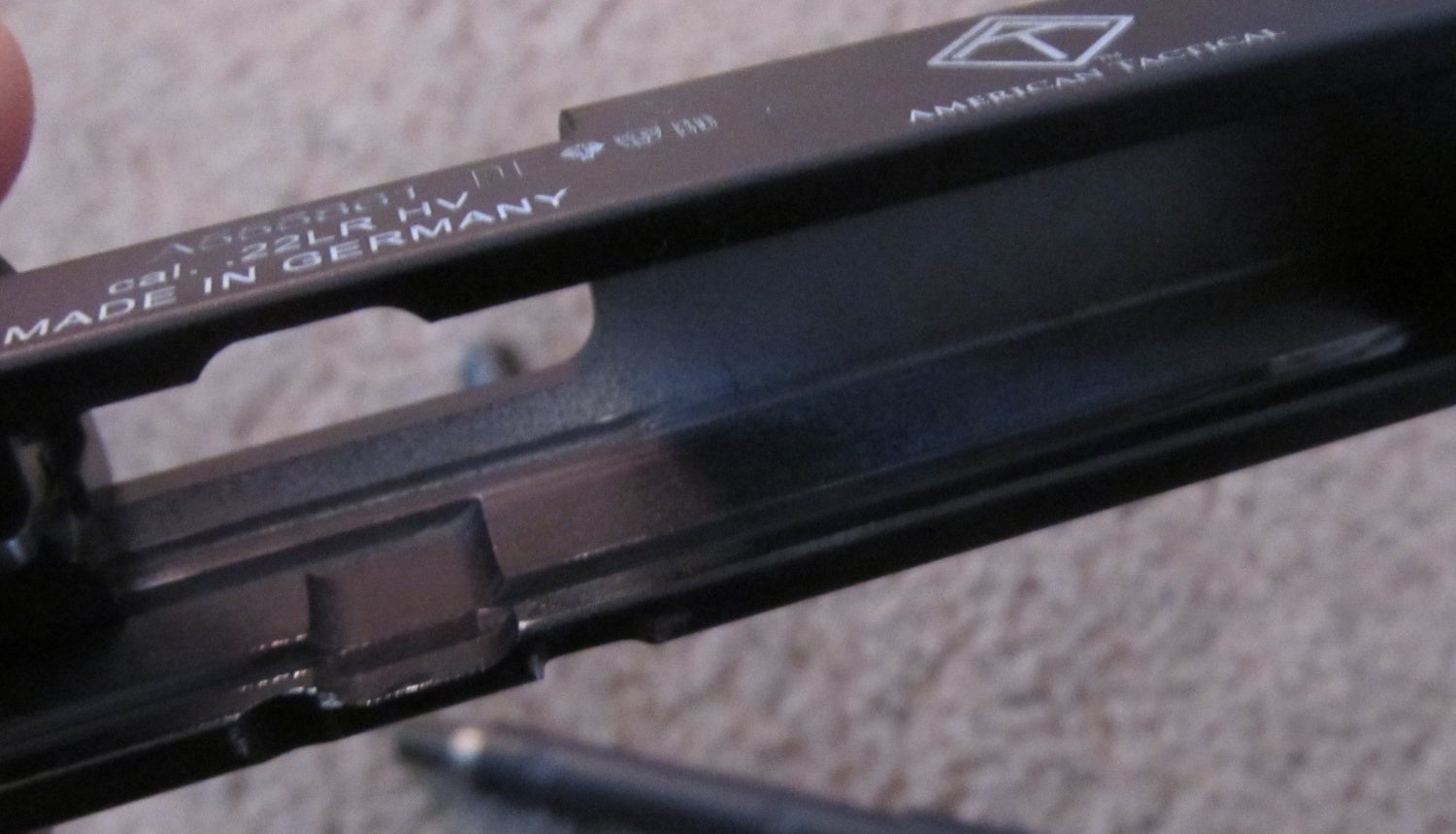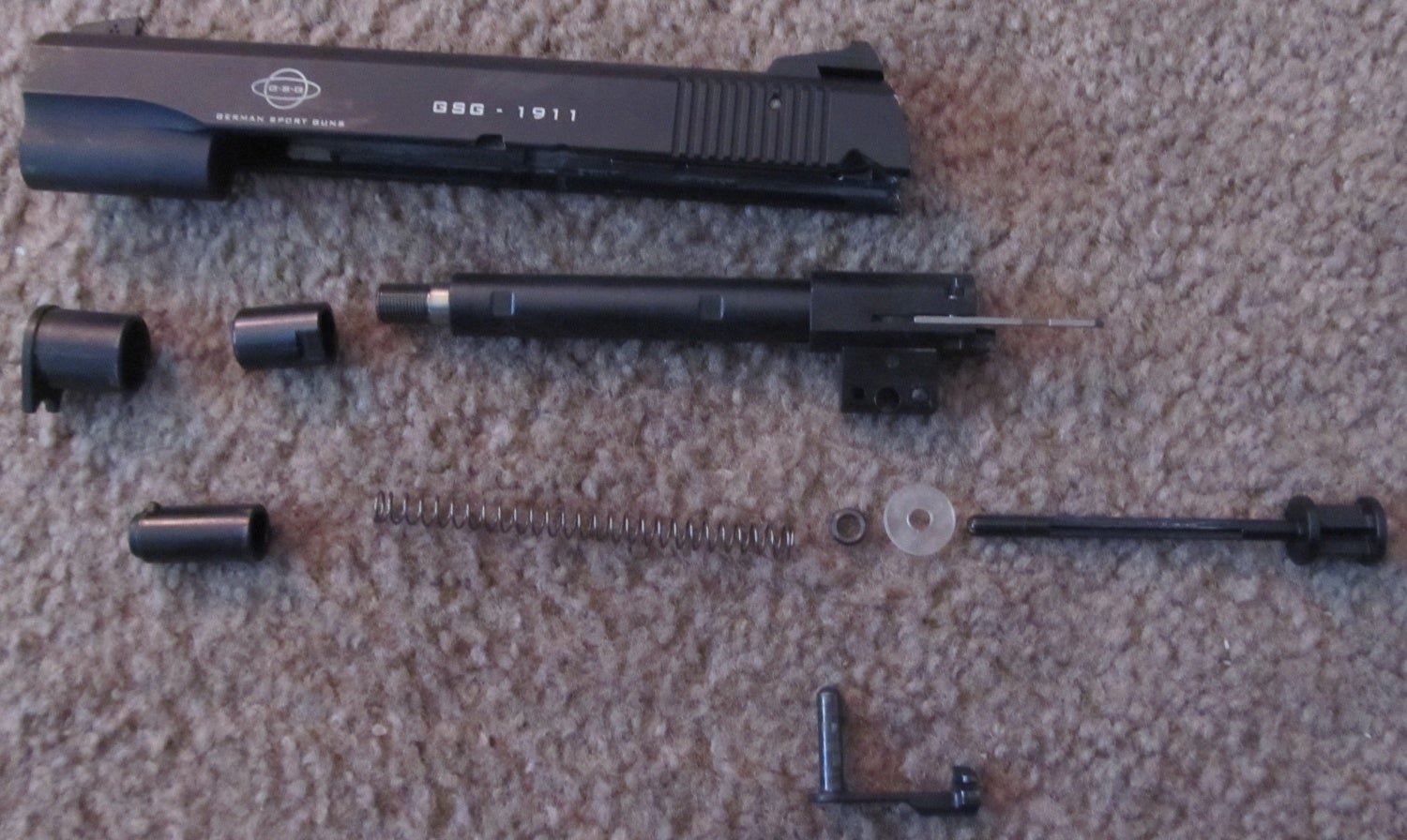The quest for a .22 LR conversion kit began when I took my Kimber commemorative Custom II to the cleaners. I had ordered a Caspian frame, along with some Ed Brown and Wilson parts, and thus was left over with the original frame. All the internals had been transferred over to the new pistol. The idea for getting a conversion kit was for two reasons. I introduce alot of people to shooting and wanted a .22 handgun so they could work on the fundamentals more. And the backwords compatibility of still having a full size 1911 being able to work in all my existing holsters, use the same procedures and techniques as with the .45 ACP versions.
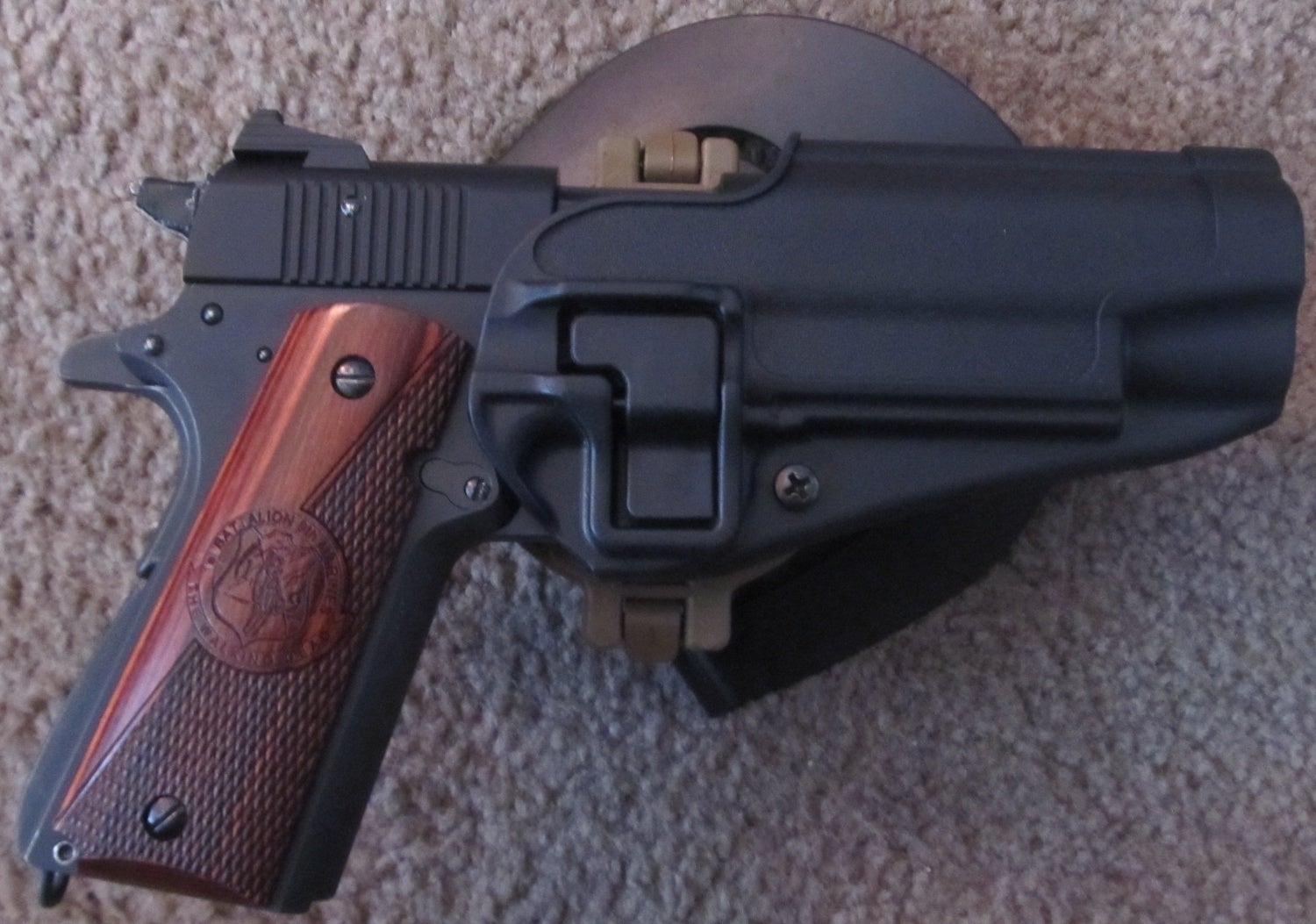
The advantages of being able to use gear dedicated to your 1911s is great, such as is the case with this SERPA holster. Note the original hammer and grip safety.
So I went looking around, and GSG really stuck out for the price. I read a number of reviews of it online, some were bad, but for the most part alot of people seemed to like it enough. Palmetto State Armory had some on sale for 150 dollars and I immediately ordered that in. In addition I ordered an internal parts kit from Sarco (which was almost 100 dollars, I didn’t expect it to be that much). When everything came into place I started putting it all together. The biggest problem was that the conversion kit is designed to work with a Series 70/80 hammer, which has a larger profile than the original 1911A1 hammer that came with the Sarco kit. This delayed the conversion kit from working because the slide wouldn’t push the older hammer back far enough so the newer version was necessary. However even with the new hammer, the problems still happened. Failure to feeds, failure to fires, stove pipes, you name it, it happened. During a particular double feed one of the bullets actually got stuck in between the two feed ramps, nose up. About the only consistent thing the gun was doing, was malfunctioning. This was extremely troublesome for myself, because I’m using it to teach new shooters and apart from focusing on the fundamentals, they were starting to become frustrated with all the jams it was having!
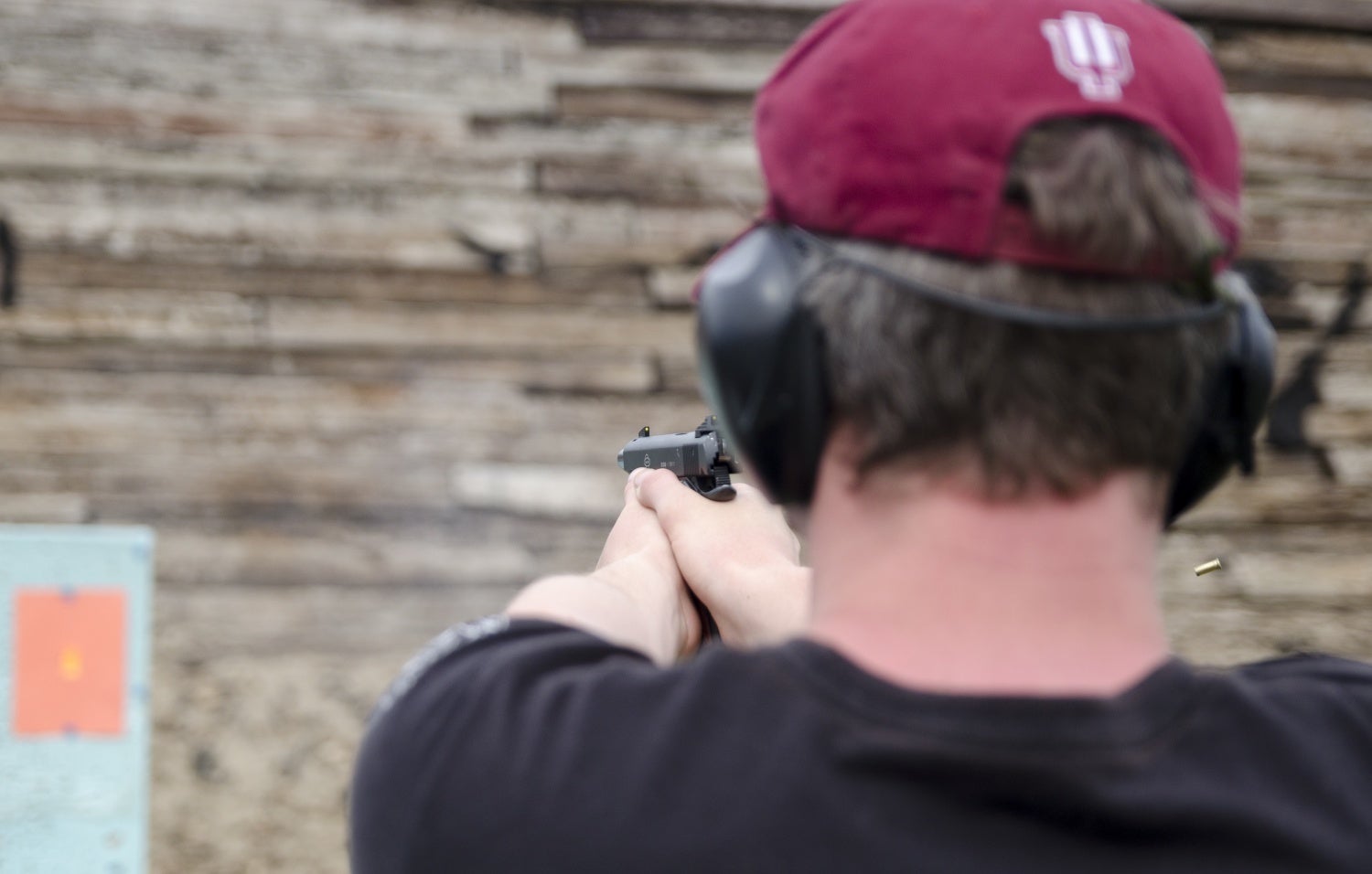
Wow! It works! Such was the reaction and frustration on working through the various problems of the kit on the Kimber frame. However, I am happy that it is in working condition now and more reliable than not, especially for my purposes of teaching.
Eventually I fished around for different ammunition and ironically enough the best ammunition I could find for the gun was Remington Golden Bullets. For some reason they worked absolutely flawlessly over American Eagle or Federal brands. These bullets usually come in 525 value packs and are considered pretty low in quality, but probably because of their velocity or chamber pressure, they function flawlessly in the conversion slide. While at the range, magazines of American Eagle and Federal were failing to fully cock the hammer and not chamber a round, sometimes on consecutive shots, the Remington bullets continued to fire away.

The addition of a Series 70/80 hammer and the original Kimber grip safety greatly enhanced the reliability of the kit. Look at the first picture in this article with the original 1911A1 hammer and grip safety.
The other fix to the problem was snipping a few coils off of the hammer spring. Being an original spring designed for a .45 slide, the spring had normal pressure for a .45 but that was just too much for a .22 slide. This caused the hammer to actually slow the slide down while it was cycling, leaving just enough room for the shell to eject, but not enough room for the slide to pick up the next round from the magazine. Thus leaving the hammer at half-cock and the shooter being stuck. With the lightened hammer spring, the American Eagle and Federal ammunition started working reliably.

Slide locked back with two magazines that come with it. The tape is so it stays somewhat centered in the magazine well while inserted.
What you get:
I will compliment GSG very thoroughly for putting the kit together because it actually comes with a ton of options and accessories for the price. Apart from the slide itself and two magazines it also comes with a muzzle wrench (for removing the front portion of the barrel, to allow a suppressor adaptor), an orange dummy round, 2 different sets of iron sights for adjustments, two chamber flags, a Series 80 conversion set, various extra screws/springs/ hex set, and a slide release. One of the neatest things about the kit is that you can have it work with either a Series 70 frame, or a Series 80 frame with a firing pin plunger. Personally I prefer the Series 70 due to the less complex design. Something about Kimber is that most Kimber frames are Series 80s with the firing pin plunger. Most 1911 companies, Springfield Armory as an example, are Series 70 frames. Not to start a Springfield versus Kimber debate, but whichever way your 1911 swings, the GSG kit can accommodate both. It also comes with a small plastic case with a foam liner. However, this is only big enough for the slide and associated parts. It will not fit an assembled 1911.

Some of the spare parts that come with the kit. It comes with a fairly decent amount of stuff considering the low price point.
Get the conversion kit if…
You want a .22 slide for your full size 1911 for recreational or light training needs. The kit is great for casual days at the range, and is especially helpful in working around jams and dealing with problems that you would have in a .45 ACP 1911. It will also fit in all your existing 1911 holsters and other associated gear. Also if you are willing to work with the slide and your pistol in making sure it becomes reliable. If you’re lucky, it’ll be a simple disassembly and will be working fine. If not, you’ll be going through springs, hammers, and magazines trying to find a solution. Or just give it to a gunsmith. On second thought, just give it to a gunsmith to have the headache instead of you, and yourself just the bill.

The kit is absolutely outstanding (once reliable) for applications such as this, teaching gun safety and the fundamentals of marksmanship to beginners, and this is what I mainly use it for.
Don’t get it if…
You want to actually get some serious practice in with it. The construction of the kit and the operation of the slide isn’t a reliable mixture at all. Sure it’ll work, but don’t expect it to always work for you. On that regard I wouldn’t recommend it at all for a trail or pest gun, it’s just too fragile to survive much abuse. In that case I’d go with one of the better kits from Advantage Arms or another conversion kit company.
The magazine situation
Thinking that some of the problems might have stemmed from the magazine and not the ammunition, I figured I might order some Kimber .22 magazines and see if they would work better with the GSG slide. Huge mistake. Not only does it not work better but the Kimber magazines don’t even fit in it. The angle of the Kimber magazine is too steep to even seat in the 1911, it just leaves about an inch of magazine hanging out of the bottom. To top it off, the Kimber magazine seems like a rip off in itself, all it consists of is a plastic magazine tube, a flimsy spring, and a follower. Kimber sells them for thirty dollars or so, but I don’t see them costing much more than ten to produce. However the other issue I was dealing with is that the GSG magazine didn’t fit perfectly within the magazine well of the Kimber frame. It rattled around inside and oftentimes didn’t seat at all. It would do this thing of halfway seating into place, and then halfway through a magazine, the entire magazine would simply fall out of the handgun. Then I would sometimes seat the magazine, hear a click, figure it was fully inserted, but the top round wouldn’t load because it wasn’t fully inserted. Thus I had to wait for two clicks, the first one with the magazine seating, and the second one with the magazine fully inserted.
A great thing about the GSG magazines is that they are designed to lock the slide open on the last round. This can’t happen at all with the Kimber conversions and some other conversion slides are iffy about this, but not with GSG. The magazines also don’t fit in standard 1911 magazine pouches or holders because they’re a tad too small. But it isn’t anything a piece of tape with cardboard can’t fix. They hold a capacity of 10 rounds, are easily disassembled for cleaning, and have rugged housings. Their weak points are mainly the floor plate, which is a piece of plastic that can be pried off of the magazine.
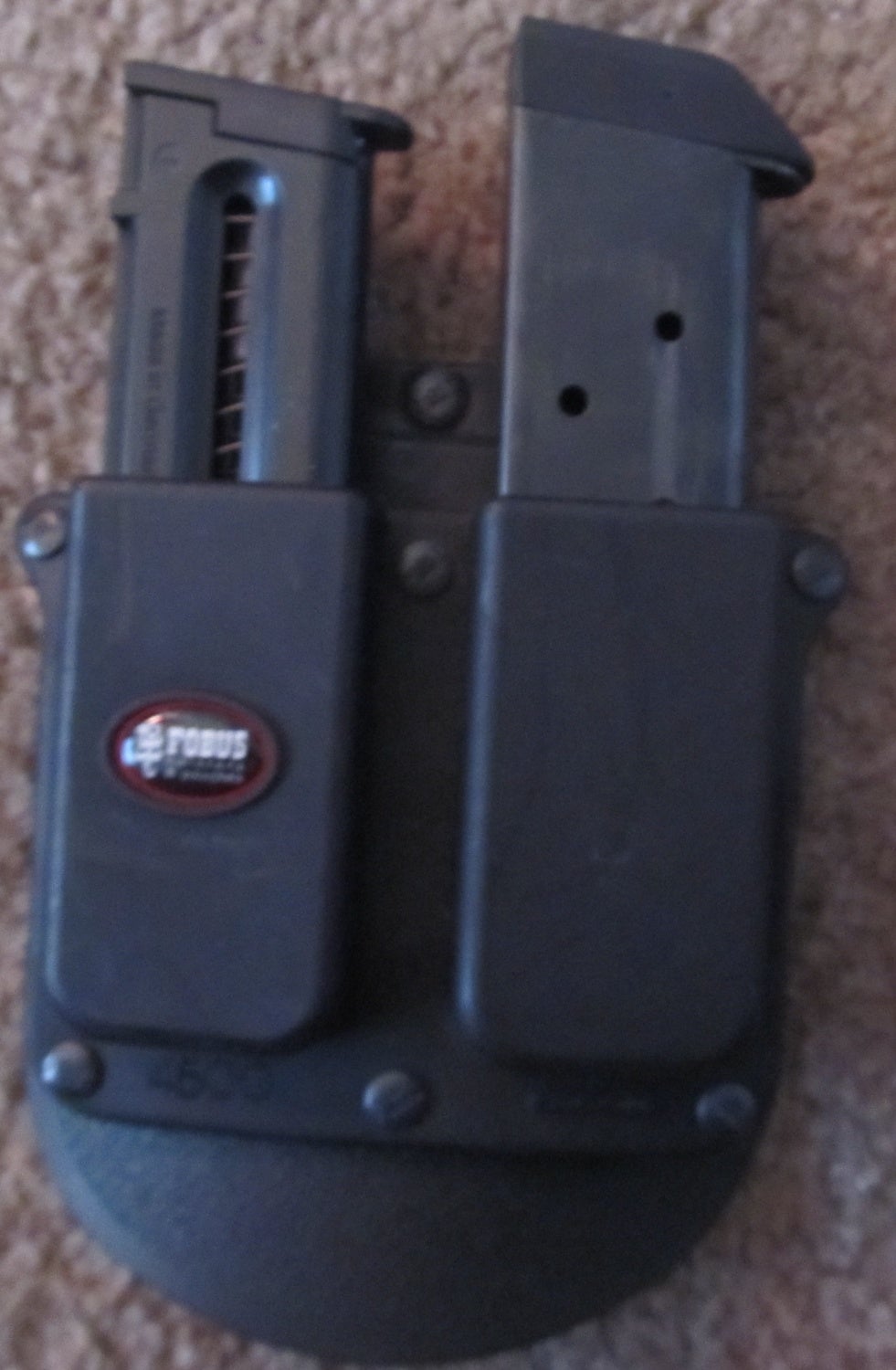
An example of how the GSG magazines fits in a magazine holder from Fobus, as compared to a standard 1911 magazine. It won’t be snug, and can easily rattle or fall out unless secured somehow.
Accuracy?
At 5 meters the groups coming out of the GSG are great, but that is only because I’m mostly shooting at 5 meter paper targets with my students. At 15 to 25 meters, the pistol is extremely capable on steel targets. As long as the shooter puts in the work, the gun will put rounds down range in pretty good groups, provided quality ammunition is used as well.
The bottom line
The end result is that the slide itself is really hit or miss. By the end of all these extra parts and ammunition, I honestly would have probably been better off just buying a used but dedicated semi automatic .22 handgun. But on the other hand, I’ve now got a legitimate 1911 frame that I can use with a .45 slide in the future, if I ever feel like putting that on. In addition I can use all or most of my 1911 parts and accessories with the gun, can practice similar loading and clearing procedures just like the full size one, and not lose any safety considerations going from one caliber to another. It is certainly economical, but at what cost? That’s up to whatever frame or platform you’re using in conjunction with it. GSG has a great reputation for making solid shooting guns. However when that conversion line is crossed, there are so many variables in the design of the firearm it is converting, that I would be hard pressed to find any conversion kit, for any firearm, that works on every single version of that particular firearm.

One of the parts that makes it really versatile is the Series 70/80 choice on it. By replacing the bar on the left side of the firing pin block, you can have either a 70 or 80 configuration. The entire block is taken out by hammering out the pin visible in black about midway on the firing pin block.
 Your Privacy Choices
Your Privacy Choices

